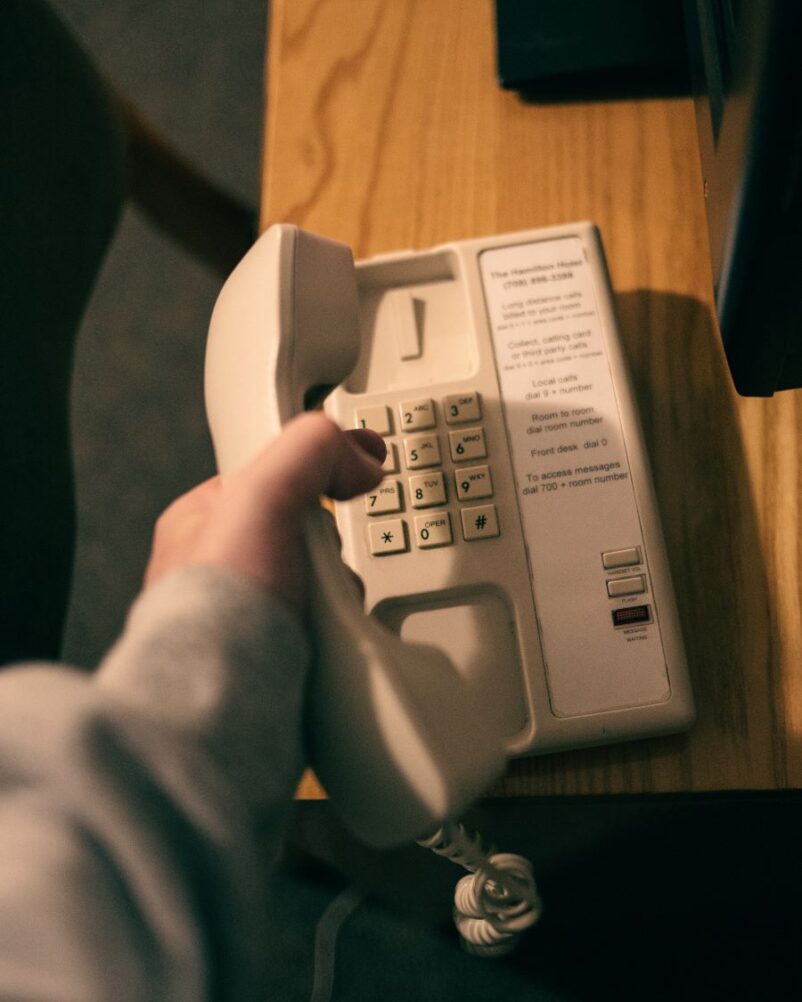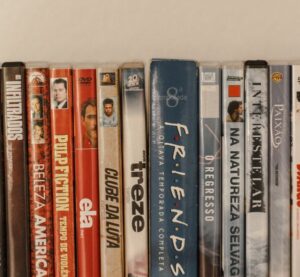
From groundbreaking technological advancements to shifting societal norms, Baby Boomers have lived through a transformative era and played a significant role in shaping the world we know today. The Boomer Generation years are most commonly defined as those of us who were born between 1946 and 1964 and named due to the spike of babies born following the end of World War II. This generation has remained the single largest group of people at every stage, and has experienced a multitude of extreme changes and cultural shifts.
My husband and I fall at the tail end of the Boomer Generation years label, often described as “Shadow Boomers.” It’s extraordinary to thing how much about culture has changed in our lifetime. However, as time marches on, there are certain aspects of life that were once prominent and even groundbreaking during their prime but now face an uncertain future. Here are 25 outdated, if not sentimental, things that are likely to come to an end with the passing of the Boomer generation years, signifying both an endearing legacy and a potential shift in our collective way of life.
-
Landline phones
Landline phones, once a standard fixture in every household, are practically obsolete today due to the rise of mobile and internet-based communication. The Boomer generation years saw witness to the transformation from rotary dial to touch-tone landline phones and even experienced the novelty of cordless phones. However, as this generation phases out, so too will their reliance on landlines.The convenience and portability offered by smartphones have rendered landline phones redundant for many individuals. With mobile devices providing instant access to calling, texting, internet browsing, and a myriad of other features all in one device, there is little need for a separate landline connection. Individuals today tend to prioritize mobility and flexibility over traditional phone options.
Further, advancements in internet technology have paved the way for Voice over Internet Protocol (VoIP) services that allow users to make calls through an internet connection rather than traditional telephone lines. This technology has gained significant popularity due to its cost-effectiveness and versatility. As more people transition towards these modern alternatives for communication purposes, landline phones have become an outdated relic of the past.
-
Physical newspapers and magazines
 Physical newspapers and magazines have long been a staple of people’s daily lives, providing a tangible source of news, entertainment, and information. However, with the rise of digital technology and the internet, these traditional mediums are facing an uncertain future. As Baby Boomers age, it is likely that the continuation of physical newspapers and magazines will mostly cease.
Physical newspapers and magazines have long been a staple of people’s daily lives, providing a tangible source of news, entertainment, and information. However, with the rise of digital technology and the internet, these traditional mediums are facing an uncertain future. As Baby Boomers age, it is likely that the continuation of physical newspapers and magazines will mostly cease.One reason for this decline is the convenience and accessibility offered by digital alternatives. With just a few taps on a smartphone or tablet, one can access countless news articles, blogs, and online magazines on any topic imaginable. This instantaneous access to information has made physical newspapers and magazines seem outdated in comparison. An often unspoken aspect of the digital as well is that articles can be updated instantaneously, compared to once-a-day delivery of the morning paper or watching the prime time news.
Additionally, as younger generations grow up in an increasingly digital world, they are becoming more accustomed to consuming content online rather than through printed materials. This shift in consumer behavior from the Boomer generation years further threatens the survival of physical newspapers and magazines as publishers struggle to attract younger readers who are more interested in engaging with content digitally. The convenience and accessibility offered by digital alternatives coupled with changing consumer behaviors make it increasingly difficult for these traditional mediums to remain relevant.
- Fax machines
Fax machines were once an essential tool for businesses and individuals alike. However, with the rise of digital communication methods, these clunky devices have mostly become obsolete. The convenience and efficiency of email, instant messaging, and online file sharing have rendered fax machines unnecessary in today’s fast-paced world.One of the main reasons why fax machines are falling out of favor is their lack of compatibility with modern technology. While other forms of communication can be easily accessed from anywhere via smartphones or computers, fax machines require physical documents to be printed and sent through a dedicated phone line. This not only adds extra steps to the process but also limits accessibility for those who do not have access to a fax machine.
Additionally, the security concerns associated with faxing have contributed to its decline. Fax messages can easily be intercepted or lost during transmission, potentially compromising sensitive information. In contrast, digital communication techniques offer robust encryption protocols that ensure secure transmission and storage of data.
- Traditional TV
Traditional TV is undeniably one of the things that will soon cease to exist after the Baby Boomer generation years. This once dominant form of entertainment, where families would gather around their living room sets to watch their favorite shows at scheduled times, is quickly becoming a relic of the past. With the rise of streaming services like Netflix, Hulu, and Amazon Prime Video, along with on-demand platforms such as YouTube and social media platforms offering video content, traditional TV is losing its grip on viewership.One key reason behind the decline of traditional TV is its lack of flexibility. Unlike streaming services that allow users to watch their favorite shows anytime and anywhere they want, traditional TV forces viewers to adhere to predetermined schedules. With busy lifestyles and an abundance of options available at our fingertips, modern consumers prefer the convenience and freedom offered by streaming platforms.
Another factor contributing to the demise of traditional TV is its outdated advertising model. Advertisers once heavily relied on television commercials as a way to reach large audiences during prime time slots. However, with advancements in technology allowing viewers to skip or fast-forward through commercials or even subscribe to ad-free services altogether, advertisers are shifting their focus towards digital marketing strategies instead.
- Handwritten letters and cards
One of the cherished traditions that will likely come to an end with the Baby Boomer generation years is the art of sending handwritten letters and cards.
In a digital age where communication primarily takes place through emails, text messages, and social media platforms, the act of sitting down to write a heartfelt letter or card has become increasingly rare. The personal touch and effort put into crafting a handwritten message are slowly being replaced by quick and impersonal electronic exchanges.
Handwritten letters and cards hold tremendous sentimental value, as they often serve as keepsakes that can be treasured for years to come. Unlike their digital counterparts, which can be easily deleted or forgotten in an inbox cluttered with countless other messages, handwritten letters provide a tangible reminder of love, friendship, or gratitude. They have the power to evoke emotions in ways that digital communication simply cannot replicate.
The decline of handwritten letters and cards also signifies a shift in our society’s values. Taking the time to sit down and pen your thoughts on paper demonstrates patience, thoughtfulness, and intentionality – qualities that may not always be prioritized in today’s fast-paced world. As the Baby Boomers generation passes on this tradition to future generations who may rely solely on technology for communication, we lose not only a meaningful form of connection but also an opportunity to slow down and show genuine care for one another.
- Christmas cards
One of the traditional practices that will likely fade away with the Baby Boomer generation years is the act of sending and receiving Christmas cards. For decades, these cards have been an essential part of the holiday season, allowing people to stay connected and spread festive cheer. However, with the rise of technology and social media, the art of sending physical cards has lost its appeal for younger generations.
For decades, these cards have been an essential part of the holiday season, allowing people to stay connected and spread festive cheer. However, with the rise of technology and social media, the art of sending physical cards has lost its appeal for younger generations.The decline in popularity can be attributed to several factors. Firstly, younger individuals now prefer instant communication through social media platforms like Facebook rather than waiting for a card to arrive in the mail. Secondly, environmental consciousness has taken center stage, making people more conscious about excessive paper waste associated with greeting cards. Lastly, as society becomes increasingly fast-paced and digitized, many find it more convenient to send e-cards or simply post a holiday message on their social media profiles.
While it’s undeniable that digital alternatives offer convenience and speed, there is still something special about receiving a physical Christmas card. The personal touch of choosing a card design specifically for someone and handwriting a thoughtful message inside holds sentimental value that cannot be replicated online. Although this tradition may eventually become obsolete after the Baby Boomer generation years, those who appreciate nostalgia will continue cherishing this tangible symbol of connection during the holiday season.
- Mail service to each person’s home
One of the things that will likely end soon is the traditional mail service at each person’s home. With the rise of technology and online communication, physical mail has become less necessary for many people. The convenience and speed of email, instant messaging, and social media platforms have made it easier than ever to connect with others instantly without relying on traditional mail services.As society becomes more environmentally conscious, there is a growing emphasis on reducing paper waste. Many companies now offer digital billing statements and online payment options instead of sending physical bills through the mail. This shift away from physical mail not only saves trees but also reduces costs for both companies and individuals.
While some Baby Boomers may still prefer receiving physical letters or packages at their doorstep, future generations are likely to rely heavily on digital communication methods. As technology continues to evolve and improve, it is expected that traditional mail service will become increasingly obsolete in favor of more efficient and eco-friendly alternatives. The post office is already preparing for this shift, and new homes now often feature a central area for mail delivery instead of the traditional mail box at residence.
- Dial-up internet connection
One of the things that will soon be a distant memory from the Boomer generation years is the dial-up internet connection. This slow and often frustrating way of accessing the internet was once cutting-edge technology, but it has become obsolete in today’s fast-paced digital world. Dial-up required users to connect their computers to a phone line and use a modem to establish an internet connection. It relied on the transmission of data through audible sounds, which were relayed through telephone lines.While dial-up may have been revolutionary at its inception, it quickly became obsolete with the advent of broadband internet. With lightning-fast speeds and always-on connectivity, broadband made dial-up seem painfully slow and inefficient. Today, most people can’t imagine tolerating the screeching sound of a modem connecting or waiting minutes for a single webpage to load. As Baby Boomers transition into retirement, they are leaving behind this relic from their past along with other outdated technologies that defined their generation.
- Alarm clocks
Alarm clocks are one of the many things that have already been forgotten from the Baby Boomer generation years. The traditional alarm clock, with its loud buzzing and clunky design, has been replaced by smartphones and other digital devices. In today’s technology-driven world, people rely on their phones to wake them up in the morning, thanks to the convenience of setting multiple alarms and using personalized tones.Further, younger generations have embraced smart home technology that includes built-in alarm systems. These systems can be synchronized with various devices and even controlled remotely via voice commands or smartphone apps. As a result, more people are opting for these modern alternatives rather than relying on a standalone alarm clock.
With each passing year, fewer households will feature a classic alarm clock sitting on their bedside tables; instead, they will become relics of an era long gone.
- Traditional gender roles in the household
Traditional gender roles in the household have been a prominent aspect of society for generations, but with the passing of the Baby Boomer generation years, these roles have mostly been phased out. In the past, it was common for men to be considered the breadwinners and providers of the family, while women were expected to take on domestic responsibilities such as cooking, cleaning, and raising children. However, as societal norms have evolved over time and with increasing emphasis on gender equality, these traditional gender roles are disappearing.One significant factor contributing to the decline of traditional gender roles in households is women’s increased participation in the workforce. With more opportunities available for education and employment outside of homemaking, many women are choosing to pursue careers rather than solely focusing on their role within the household. This shift has led to a greater sharing of responsibilities between partners and a more equal division of labor within households.
Changing attitudes towards masculinity and femininity have also played a role in reshaping traditional gender roles. Society’s understanding of what it means to be masculine or feminine has become less rigid over time. Men are now encouraged to embrace their nurturing side and actively participate in caregiving activities traditionally associated with women. Similarly, women are no longer limited by stereotypes that confined them to domestic tasks alone. As a result, couples today are challenging traditional expectations by creating partnerships based on shared responsibilities rather than strictly adhering to predetermined gender roles within their households.
- Printed photographs
Printed photographs have been a cherished part of our memories for generations, but sadly, they are becoming a thing of the past. With the advent of digital cameras and smartphones, people now have hundreds, if not thousands, of photos stored on their devices or in the cloud. The concept of developing film and printing pictures has become obsolete as most individuals prefer to view and share their images electronically.In addition to technology advancements rendering printed photographs obsolete, another contributing factor is the decrease in physical photo albums. Baby Boomers were notorious for meticulously curating their family photo albums, creating tangible keepsakes that could be passed down through generations.
However, with the rise of social media platforms like Instagram and Facebook, people now showcase their memories online rather than in physical albums.
The decline in printed photographs signifies more than just an evolution in technology; it represents a shift in how we preserve and share our memories. As the Baby Boomer generation years dim, so does this tradition of flipping through old photo albums and reminiscing about bygone eras. While modern technology offers convenience and accessibility to our vast collection of digital photos, there is something undeniably special about holding a physical photograph in your hands – a piece of history frozen in time.
- Personal cameras
 Personal cameras have been an integral part of the Baby Boomer generation’s lives, capturing countless memories and moments. However, with the advancement of technology and the rise of smartphones, it seems that personal cameras are becoming obsolete. Gone are the days when people carried around their trusty film cameras or even digital point-and-shoots to document their adventures.
Personal cameras have been an integral part of the Baby Boomer generation’s lives, capturing countless memories and moments. However, with the advancement of technology and the rise of smartphones, it seems that personal cameras are becoming obsolete. Gone are the days when people carried around their trusty film cameras or even digital point-and-shoots to document their adventures.
Smartphones now offer high-quality built-in cameras that are always within reach, making them more convenient and practical for everyday photography. With just a few taps, one can capture stunning photos and share them instantly on social media platforms. The ease of use and accessibility offered by smartphones has made personal cameras less appealing to Baby Boomers, who may find it unnecessary to invest in a separate device solely for photography purposes.
Also, as smartphones continue to evolve with advanced camera features like portrait mode and image stabilization, they have become versatile tools capable of capturing professional-grade shots. This shift in technology has not only influenced how Baby Boomers approach photography but also changed the way they consume visual content. Personal cameras may be seen as relics from a bygone era as younger generations embrace the convenience and quality offered by smartphone photography.
- Shopping malls
Malls, once bustling hubs of consumerism and social activity, are among the things that will likely come to an end with the decline of Baby Boomer generation years. Traditionally a popular gathering place for this generation, malls have been gradually losing their appeal in recent years. The rise of online shopping and the convenience it offers has significantly impacted brick-and-mortar retail stores, leading to a decline in foot traffic within malls.As Baby Boomers age and retire, their spending habits are expected to shift towards more essential items rather than discretionary purchases. This change in consumer behavior will further contribute to the downfall of malls as they struggle to attract customers without the strong purchasing power of Boomers.
The closure or transformation of many malls into mixed-use spaces such as offices or apartments is already becoming a common trend across various regions.
- Typewriters
One of the most iconic objects that has already mostly faded away with the Boomer generation years is the typewriter. Once an indispensable tool for writers and office workers, typewriters have been rendered obsolete in the digital age. These machines revolutionized communication during their heyday, offering a tangible experience as words were physically imprinted onto paper with each keystroke. However, advancements in technology have made way for computers and laptops, making typewriters more of a nostalgic relic than a practical device.Typewriters often hold sentimental value for many Baby Boomers who recall using them during their school or early work years. The distinct clattering sound of keys being struck and the manual carriage return evoke memories of a bygone era when writing required patience and precision. Today, digital keyboards offer speed, convenience, and countless editing options that simply cannot be matched by typewriters.
As younger generations embrace virtual keyboards on touchscreens or sleek wireless devices, it’s unlikely they will ever fully understand the unique charm and significance of these mechanical wonders.
- VHS tapes and DVDs
 VHS tapes and DVDs have been a staple in the entertainment industry for decades, but with the rise of digital streaming services, their days are numbered. Baby Boomers, who grew up during the peak era of VHS tapes and DVDs, will likely be one of the last generations to truly appreciate these physical formats.
VHS tapes and DVDs have been a staple in the entertainment industry for decades, but with the rise of digital streaming services, their days are numbered. Baby Boomers, who grew up during the peak era of VHS tapes and DVDs, will likely be one of the last generations to truly appreciate these physical formats.
VHS tapes were revolutionary when they first hit the market in the 1970s, allowing people to watch movies from home without going to theaters. However, their bulky size and limited storage capacity quickly became drawbacks as technology advanced. DVDs came along in the late 1990s and offered better picture quality and more compact designs compared to VHS tapes. They became incredibly popular among Baby Boomers who were eager to upgrade their movie collections.
Despite their popularity throughout Baby Boomers’ lives, VHS tapes and DVDs have been replaced by streaming services. The convenience of streaming eliminates the need for physical copies that can clutter shelves or require changing discs every time you want to watch something new. As a result, future generations may never fully understand the nostalgia associated with hunting down your favorite movie on VHS or DVD at Blockbuster video stores or eagerly waiting for mail-order rental subscriptions like Netflix’s original model.
- Paper checks
Paper checks are one of the things that will likely become a past memory soon. In an increasingly digital age, where electronic payment methods have become more convenient and popular, paper checks seem outdated and time-consuming. With the rise of online banking and mobile payment apps, younger generations are opting for faster and more secure ways to transfer money.The use of paper checks has been declining for years as technology advances. Writing a check requires multiple steps: filling out all the necessary details, signing it, waiting for it to clear, and then physically depositing or mailing it to the recipient’s bank. This process can be inefficient when compared to electronic payment options like credit cards or digital wallets.
Also, security concerns associated with paper checks make them less appealing in today’s world. Paper checks can be easily lost or stolen during transit, putting sensitive financial information at risk. In contrast, digital payments offer encryption protocols and authentication measures that provide a higher level of security.
- Personal service bank tellers
Personal service bank tellers have long been a staple of the banking industry, providing face-to-face interactions and personalized assistance to customers. However, as Baby Boomers gradually retire and new generations embrace digital banking solutions, the role of personal service bank tellers is at risk of disappearing altogether.One reason for the decline in demand for personal service bank tellers is the increasing popularity of online and mobile banking. With just a few clicks or taps, customers can access their accounts, make transactions, and even apply for loans or credit cards. These convenient digital services not only save time but also offer added security features that give customers peace of mind.
Another factor contributing to the potential demise of personal service bank tellers is the automation of routine banking tasks. Self-service kiosks and ATMs are now capable of handling cash deposits, withdrawals, check deposits, account transfers, and other basic transactions without human intervention. As such technologies become more sophisticated and user-friendly, they provide an efficient alternative to traditional face-to-face interactions with a bank teller.
But it’s important to keep in mind that financial professionals can do what automation can’t: give personalized, custom advise about retirement options, savings, and using credit cards, for starters.
- Paper applications
 One of the things that will likely end with Boomer generation years is the use of paper applications. In previous decades, when applying for a job or a credit card, individuals were required to fill out a paper application form. This process involved printing out the form, filling it in by hand, and then either mailing it or physically dropping it off at the desired location. However, as technology has advanced and online platforms have become more prevalent, paper applications are slowly becoming obsolete.
One of the things that will likely end with Boomer generation years is the use of paper applications. In previous decades, when applying for a job or a credit card, individuals were required to fill out a paper application form. This process involved printing out the form, filling it in by hand, and then either mailing it or physically dropping it off at the desired location. However, as technology has advanced and online platforms have become more prevalent, paper applications are slowly becoming obsolete.
The shift away from paper applications can primarily be attributed to the convenience and efficiency offered by online alternatives. With just a few clicks, individuals can now submit their applications electronically from anywhere in the world. Online application systems also provide real-time updates on application status and allow for immediate communication between applicants and employers or financial institutions. Digital applications significantly reduce paperwork for companies and streamline their hiring processes.
The younger generations who have grown up with smartphones and instant access to information are accustomed to conducting activities digitally rather than relying on manual paperwork. As Baby Boomers retire from their positions of influence within organizations and society as a whole, we can expect the era of paper applications to come to an end along with them.
- Personal job interviews
The days of conducting a first or second round of a job interview in person is practically over for most positions. Why meet in person when an interview can be conducted over Zoom or Teams?Efficiency is the main reason for the end of an in-person job interview. While some companies may still opt to have final interviews on certain positions in person, many applicants go through the entire interviewing process without stepping foot into the actual office. Job interviews conducted remotely take far less time for both the applicant as well as the hiring person or team. Instead of the panel having to meet in person to meet candidates, each can simply “meet” over the computer while remaining at their desk. It is especially efficient when employees in charge of picking a person work in different offices or even site locations.
Expect this time-intense hiring aspect to mostly disappear for skilled office positions, although there will always be on-the-spot hiring calls or job fairs for hard-to-fill jobs.
- Jukeboxes
Jukeboxes, once a common sight in diners and bars, are now becoming part of a bygone era with the Baby Boomers. These iconic machines were first introduced in the 1920s and quickly gained popularity among young people. They provided a way for individuals to select and play their favorite songs from a vast collection of vinyl records. However, with the rise of digital music streaming platforms and personal devices like smartphones, jukeboxes have lost their appeal.
They provided a way for individuals to select and play their favorite songs from a vast collection of vinyl records. However, with the rise of digital music streaming platforms and personal devices like smartphones, jukeboxes have lost their appeal.
The decline of jukeboxes can be attributed to several factors. Firstly, the convenience offered by online music services has made it easier than ever for people to access any song they desire at any time. Additionally, as technology advanced, the physical limitations of jukeboxes became more apparent. They could only hold a limited number of records at a time and required regular maintenance to keep them functioning properly.
Although jukeboxes may hold sentimental value throughout the Baby Boomer generation years, younger generations have little interest or nostalgia for this once-revered entertainment medium.
- China cabinets
China cabinets have long been a staple in traditional homes and are often associated with the Boomer generation years. These elegant pieces of furniture were once considered essential for storing and displaying fine china, glassware, and other delicate items. However, it is likely that the era of china cabinets will soon come to an end. One reason for this shift is changing lifestyles and home decor preferences. The younger generations tend to favor more minimalist or modern designs that emphasize functionality over ornate displays.
One reason for this shift is changing lifestyles and home decor preferences. The younger generations tend to favor more minimalist or modern designs that emphasize functionality over ornate displays. With open concept living spaces becoming increasingly popular, the need for a dedicated china cabinet diminishes as people opt for sleeker storage solutions or integrated shelving.
Additionally, the decline of formal dining has contributed to the waning popularity of china cabinets. Traditional family dinners around a formal dining table have become less common in today’s fast-paced world. As casual dining options such as breakfast bars and kitchen islands gain prominence, there is less demand for elaborate table settings and extensive collections of fine china.
- Using cash
One of the things that will likely end with the Baby Boomers generation years is the widespread use of cash as a primary form of payment. As the younger generations, such as Gen X, Millennials, and Gen Z, continue to embrace digital technologies and online platforms, cash transactions are gradually becoming less common.With the rise of mobile payment apps like Apple Pay, Google Wallet, and Venmo, people are now more inclined to make purchases electronically using their smartphones or other devices. This shift away from cash can be attributed to several factors including convenience, security concerns associated with carrying large amounts of cash, and the increasing acceptance of digital payments by businesses worldwide.
As we move further into a digitally driven society, it’s clear that using cash will become increasingly outdated. Many countries have already begun implementing policies to encourage electronic forms of payment in an effort to reduce counterfeiting and money laundering.
Additionally, the COVID-19 pandemic has accelerated this transition as contactless payments have become more prevalent due to hygiene concerns. As Baby Boomers age out of the workforce and younger generations take over consumer markets and financial decision-making roles within businesses, it is highly likely that using physical cash will become a relic of the past.

While there may still be instances where cash is required or preferred for certain transactions or in specific regions where digital infrastructure may not be as developed, overall it seems evident that the era dominated by physical currency is coming to an end with Baby Boomers.
- Facebook as the key social media platform
One of the key reasons why Facebook (Meta) is considered the key social media platform for Boomers is its widespread usage among this generation. With over 60 percent of Baby Boomers active on Facebook, it has become their primary means of staying connected with family and friends. This platform allows them to easily share photos, updates, and memories, bridging the physical distance that might separate them from loved ones.However, younger generations have shied away from Facebook as much, in part because it is their parents (or even grandparents) platform. Instead, they opt for trendier social media platforms such as TikTok. This isn’t to say Facebook is disappearing, but its creators will need to do something –and fast—to attract a new generation.
- Staying with the same job for an entire career
As the Baby Boomers are reaching retirement age, one aspect of their generation that is slowly fading away is staying with the same job for an entire career. This trend was common among Baby Boomers due to factors such as job security, company loyalty, and limited opportunities for advancement or career change. However, with the rise of technology and a more dynamic job market, younger generations are increasingly opting for multiple career changes throughout their working lives.With automation and artificial intelligence becoming more integrated into various industries, many jobs have become obsolete or require new skill sets. As a result, employees must continually adapt and acquire new skills to stay relevant in their careers. And that means moving around.
Moreover, younger generations are prioritizing personal growth and fulfillment over long-term stability. They value job satisfaction and work-life balance more than previous generations did. This mindset often leads them to pursue different opportunities that align better with their passions and goals rather than staying put in one job indefinitely.
Overall, while it may have been common during the Baby Boomer generation years to stay with the same job for an entire career, this trend is gradually changing as younger generations embrace flexibility and prioritize personal growth in today’s ever-evolving work sphere.
- Traditional funerals
Traditional funerals have long been a significant part of many cultures around the world. These ceremonies typically follow a specific set of rituals and customs, involving religious or cultural practices that vary from one community to another. The funeral process often begins with a wake or visitation, where family and friends gather to pay their respects and offer condolences to the grieving family. This is usually followed by a formal funeral service, conducted by religious leaders or officiants who guide mourners through prayers, hymns, eulogies, and other ceremonial activities.One key aspect of traditional funerals is the viewing or open casket ceremony, allowing mourners to see the deceased for one last time before burial or cremation takes place. This practice provides closure for loved ones while honoring the life of the deceased. Another common feature is the procession from the place of worship or funeral home to the final resting place, be it a cemetery or crematorium. Carrying coffins on shoulders in solemn cadence has been a tradition across generations.
However, as Boomers age and pass away, traditional funerals are expected to undergo significant changes in their prevalence and nature. With evolving attitudes towards death and mourning rituals among younger generations, traditional funerals may gradually give way to more personalized celebrations of life that reflect individual preferences rather than following established customs. As society becomes increasingly diverse and secularized as well, there may be an increased demand for alternative end-of-life ceremonies that cater to different cultural beliefs and spiritual practices beyond traditional funeral rites.
Well, there you have it! These are 25 things that will (or already have) fade away, but there are so many more!
We’d love to hear from you about things you believe will end after the Boomer generation years, along with any special memories you may have had about them. One thing not on the list but is full of memories for me is playing 8-track tapes (then cassettes) while cruising on the weekends. Good times!
Contact Us
Written by
Robin McClure
Robin is the author of 7 parenting books and has 3 grown children, 3 spoiled rescue dogs, and a very understanding husband. She holds a bachelor's degree in journalism and a master's degree in communications, and spends her time writing, drinking coffee, and planning the next grand adventure.



